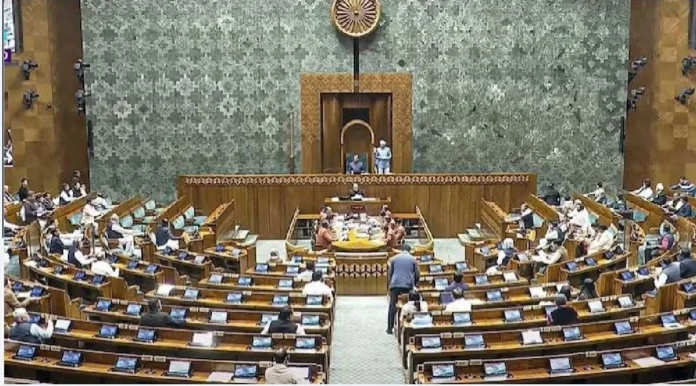By Kumkum Chadha
Two speeches last week defined the proceedings in Parliament—one by Leader of the Opposition Rahul Gandhi and the other by Prime Minister Narendra Modi. Both addressed the Motion of Thanks to the President’s speech, setting the stage for a high-voltage political showdown.
President Droupadi Murmu, in keeping with tradition, delivered her address to both Houses of Parliament at the start of the Budget session. However, the controversy that erupted soon after overshadowed her speech, drawing sharp political reactions.
The Sonia Gandhi Controversy
A video clip making the rounds on social media captured Congress leader Sonia Gandhi’s off-the-cuff remark about the President: “The poor lady, the President, was getting very tired by the end… she could hardly speak, poor thing.”
This was enough for the BJP to launch an all-out attack on the Congress. Priyanka Gandhi Vadra’s defense of her mother—calling her a “78-year-old lady”—did little to douse the fire.
Prime Minister Modi, never one to miss an opportunity, took the controversy to the floor of the House. Without naming anyone, he took a swipe at the Gandhi family’s perceived elitism: “Those who have photo sessions in the huts of the poor to entertain themselves will find talk of the poor in Parliament boring.”
Modi also hit out at the Congress’s repeated calls for a caste census, questioning the party’s track record in empowering marginalized communities. “Have there ever been three MPs simultaneously from the same family from the SC community? Have there ever been three MPs simultaneously from the same family belonging to the ST community?”It was an unmistakable jibe at the Gandhis—Sonia, Rahul, and Priyanka—who are all members of Parliament.
Rahul Gandhi’S Speech: A Strong Start, A Fading Finish
A day before Modi’s address, Rahul Gandhi took on the government over its foreign policy, particularly its handling of China. He alleged that Modi’s denial of Chinese intrusions was at odds with the Army’s position.
In a rare departure from his usual tone, Gandhi momentarily acknowledged the merits of Modi’s Make in India initiative—an unexpected move given his relentless criticism of the Prime Minister.
His speech had flashes of substance, especially on foreign policy, indicating that he had done his homework. But somewhere along the way, he lost the plot.
The Curious Case Of The India Bloc
Perhaps the most baffling moment in Rahul Gandhi’s speech was his attempt to project an “alternative vision” of what a President’s address would look like under an INDIA bloc government. But where is the INDIA bloc? Is it even functional?
The Opposition alliance, formed to challenge the BJP in the 2024 Lok Sabha elections, initially showed promise. The results were encouraging—the BJP secured 240 seats, just six more than the bloc’s 234. However, the momentum was short-lived.
In subsequent state elections, alliance partners worked at cross purposes. In Jharkhand, they fought against each other. In Delhi, some INDIA bloc members backed the Aam Aadmi Party (AAP), while the Congress—the biggest bloc member—fought AAP’s founder, Arvind Kejriwal. During the campaign, Rahul Gandhi called Kejriwal a “liar, cunning, and a scamster.” Kejriwal, in turn, accused the Congress of having a secret pact with the BJP. Such open hostility between allies raises a fundamental question: How can an alliance that tears itself apart in the states present a united front at the national level?
Congress: The Chief Disrupter Of The India Bloc?
Many within the Opposition blame the Congress—and Rahul Gandhi in particular—for the disarray in the INDIA bloc. While regional parties resent Congress’s big brother attitude, leaders like Mamata Banerjee believe Gandhi lacks the competence to lead the alliance. There was even talk of Banerjee leading the bloc, while some pitched Congress President Mallikarjun Kharge as an alternative. But no consensus has emerged.
Moreover, Congress’s insistence on targeting industrialist Gautam Adani last year alienated several allies, including the Trinamool Congress and the Samajwadi Party. Despite their opposition, Rahul Gandhi kept hammering the issue.
Jammu and Kashmir Chief Minister Omar Abdullah went a step further, calling for the disbanding of the INDIA bloc, citing a lack of clarity about its future.
Rahul Gandhi: A Leader Without A Team?
For Gandhi to speak of an INDIA bloc government while ignoring its dysfunction is to miss the woods for the trees.
A few lessons are in order. First, a mature leader takes allies along; Gandhi has done the opposite. Many view him as the Chief Disrupter of what could have been a formidable Opposition.
The INDIA bloc’s Lok Sabha performance was encouraging, but instead of capitalizing on it, its members fell into a game of one-upmanship.
Had they remained united, Modi might not have had the confidence to make this bold assertion in Parliament: “This is just our third term.”
A clear signal that the INDIA bloc government Rahul Gandhi spoke of is little more than a pipe dream.
Modi Vs Gandhi: The Stark Reality
The debate is no longer about whether the INDIA bloc will survive or whether Rahul Gandhi has leadership qualities—it is about the larger national picture.
The Congress is desperate to pitch Rahul vs Modi, but there is no real contest. Even Modi’s harshest critics—those who oppose his communal and divisive politics—acknowledge that he has a vision for India, has elevated the country’s global standing, and commands international attention.
Rahul Gandhi, meanwhile, still struggles with the basics. Yes, he has matured over the years, but the gaps remain too wide for him to challenge Modi.
The INDIA bloc was a promising experiment, but it has been undone by internal strife and poor leadership. In this political chess game, Modi is already strategizing for beyond 2029, while Rahul Gandhi is still figuring out his next move.
—The writer is an author, journalist and political commentator


